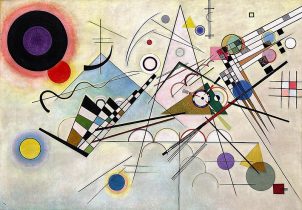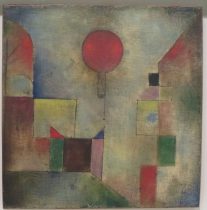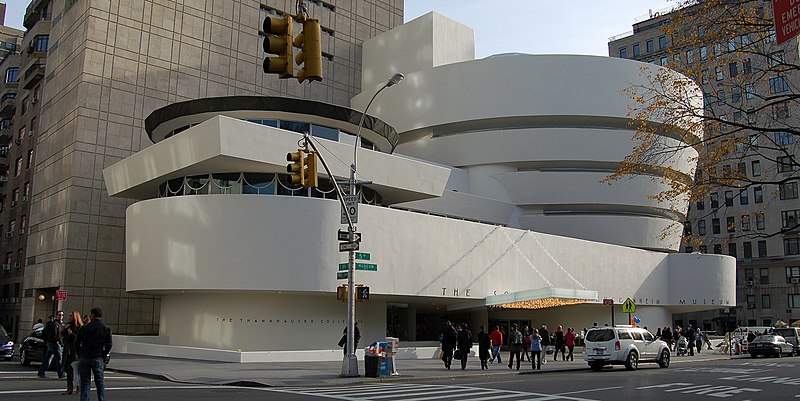New York City is filled with breathtaking collections of art, from the Museum of Modern Art to the world-renown Metropolitan Museum of Art. However, there is one museum that is overlooked: the Guggenheim. Located on 5th and 88th, the Guggenheim not only overlooks Central Park but also stands out among the flat facades of the skyscrapers around it. Designed in 1959 by Frank Lloyd Wright for Solomon Guggenheim, it was one of the first museums in New York to feature what Mr. Guggenheim called ‘non-objective art’. Wright was commissioned for the project in 1947, however, construction would not begin until 1956, seven years after Guggenheim’s death. The building was, in Wright’s words, made to be “the best possible atmosphere in which to show fine paintings or listen to music”1. From the beginning, this building was made to stand out not only against the backdrop of the bustling metropolis but also to stand as an example of modern architecture and art museums. The iconic design would go on to captivate the crowds during its grand opening and would stand more as a monument to the genius of Frank Lloyd Wright than as solely an art museum.

Solomon Guggenheim was an American businessman and art collector. He was born into a wealthy gold mining family in Alaska in 1861. He began to collect pieces of art in the 1890’s and would pursue this passion full-time after the conclusion of World War I, switching to a focus on modern art under the guidance of Baroness Hilla Von Rebay, who was also an artist. It was the Baroness that guided Guggenheim to open an initial collection, called the “Museum of Non-Objective Painting” on East 54th Street in 19392. It was here that Guggenheim would display the most important pieces of modern art, such as Kandinsky’s Komposition 8. As his collection grew, Guggenheim would come to realize he needed a new permanent building that allotted more space to the pieces. Thus, the Baroness would contact Wright to design the bold, new museum.
To understand the significance of the Guggenheim in its entirety, one must understand who Frank Lloyd Wright was and who he was in terms of the architectural scene. Wright grew up in rural Wisconsin, surrounded by nature and a laid-back lifestyle. When he began training as an architect under Louis Sullivan in Chicago, Wright was aghast at the dirty streets, the constant noise, and the traffic and chaos of everyday life. It was during the early 1900s that he and a small group of architects would begin experimenting with a new style, one that would draw on their love of nature and modern aesthetics: Prairie Style. Prairie Style architecture was a way for city houses to bring nature into the city on a small scale, thus breaking up the suffocating materials of concrete, glass, and bricks3. One famous example is the Robie House. Built by Wright in 1909, the Frederick C. Robie House is located in Hyde Park in Chicago, Illinois. This particular example is interesting because it was the first house to break away from the Victorian aesthetic, making it wholly unique after its construction. The floorplan is open and very free-flowing, allowing for tons of breathable space both inside and out. However, the house’s most striking feature is the horizontal construction. The house itself almost appears to be made of rectangles lying on their sides, giving off a grandiose impression, as the house eats up horizontal space and presents an almost imposing facade4. This house is just the beginning, so to speak. Wright had yet to reach his peak, which many would argue is the Guggenheim museum. Wright would continue to experiment with unusual designs and shapes to great success, making him one of the most interesting and important architects in America at the time.
Turning back to the museum itself, we can now see the bigger meaning behind the building. Tragically, Wright would pass away in April of 1959 at the age of 91, just six months before the grand opening. However, despite the museum’s legendary creator, the building itself would face some backlash around its unconventional look. For example, one opinion piece published by the New York Times shortly after the opening of the museum is quite dismayed at the building: “The paintings project from the wall on long metal arms attached to the centers of their backs… seeming to float in space, dramatically. They are thus beautifully revealed, but at the expense of the total architectural harmony. They occupy their space… like intruders”5. The jarring display technique aside, Canaday goes on to critique the famous rotunda, saying that “the snail-curl is a kind of straight jacket for the visitor. No wandering back and forth from one favorite picture to another”. Interestingly, his main issues with the museum are not with the odd look, but with the ergonomics of using the museum. Canaday also mentions that there are no convenient doors to quickly go between exhibits, instead of having to go back to the long hallway to wind your way around to various paintings. He was also not alone in his complaints. One man wrote an opinion piece in support of Canaday’s critiques in November of the same year, saying; “I believe that John Canaday is justified in saying in his story of Oct. 21 on the opening of the Guggenheim Museum that it fails both as architecture and as a place to show paintings and sculpture”6. Obviously, the museum had some growing pains that had to be rectified. However, not everyone felt that the building would dominate the art. Emily Genauer wrote:
Nobody had imagined that it would be like this. Not the architects who carefully studied the plans when they were first published six years ago. Not the eminent avant-garde artists who in 1956 bitterly protested…Not the museum men all over the country who clucked in sympathy for the director who would be saddled with a building… would inevitably and murderously dominate any display of paintings or sculpture housed in it… Not even the relatively few who believed in Mr. Wright’s genius and insisted that genius must be taken on faith.7
The museum was clearly a divisive building for critics and visitors alike, as many older critics felt the building dominated the visitor’s attention and thus the art was almost seen as less important. This could not be further from the truth.
The concept of the Guggenheim was not new, the Museum of Modern Art opened in New York City in 1929 and even then the idea of a “modern art museum” dates back as far as the early 1800s to the Musee de Luxembourg in France. However, the Guggenheim museum was impressive because of the vast size of the collection and because of the unique ways of experiencing the art, such as having all of the art be in one giant room instead of multiple smaller ones. Among the various pieces, some stand out above the rest. For example, Wassily Kandinsky’s Komposition 8, a piece that has been in Guggenheim’s personal collection, remains one of the most popular works, according to the Guggenheim Museum8. Another popular piece is Faith Ringgold’s Woman on a Bridge #1 of 5: Tar Beach. Painted in 1988, Ringgold uses a story quilt, a traditional American craft, to shift the focus of her work onto her narrative rather than dazzling viewers with technique. His work tells a story of a young girl who can fly and is truly free. Obviously, the deeper meaning is what is most crucial. Because the girl can fly and is free, she has no worries about the world, she can go anywhere she likes at any time. She decides to use this freedom, as Ringgold says “by confronting this huge masculine icon—the bridge”9. The art itself is fairly reminiscent of the murals one might see at a YMCA. It depicts a group of people– city dwellers– on their rooftop sitting around a table and having a nice dinner. There is watermelon and other summertime foods scattered around them, so we can tell when this takes place. If one looks at the background, one will see a sprawling city dominated by a giant bridge. Above the bridge is a little girl, flying through the air in what seems to be a dress or oversized shirt. The feeling it evokes is that of almost childlike wonder Another popular piece is Paul Klee’s Red Balloon. The most striking feature of this work is the landscape. It is left barren of activity and, for the most part, even vibrancy. The muted, dreary colors naturally filter out and your eye is drawn to the main source of color: the red hot air balloon.

The Guggenheim museum may not have been the first modern art museum, and in fact, it was not even the second. However, the Guggenheim offers a completely unique experience by having no separate rooms for exhibits and collections. The previously mentioned pieces are a small drop in the bucket of interesting, important paintings and sculptures. As a matter of fact, the museum was even named a UNESCO World Heritage Site in 201910. All of the art is in one melting pot, allowing visitors to take in all of the unique and bold works spanning every wall. The incredible collection combined with Wright’s legendary design of the building provides for a truly memorable experience for anyone even mildly interested in modern and contemporary art.
Bibliography
File:Guggenheim Museum, New York City, U.S.A.jpg. June 17, 2019. Photograph. Wikimedia Commons. https://commons.wikimedia.org/wiki/File:Guggenheim_Museum,_New_York_City,_U.S.A.jpg.
“THE ARCHITECTURAL FORUM: FRANK LLOYD WRIGHT.” The Architectural Forum 88, January 1948.
“File:Kandinsky – Composition 8, 1923.Jpg – Wikimedia Commons.” Wikimedia, September 13, 2009. https://commons.wikimedia.org/wiki/File:Kandinsky_-_Composition_8,_1923.jpg.
“File:Red Balloon.JPG – Wikimedia Commons.” Wikimedia , March 18, 2017. https://commons.wikimedia.org/wiki/File:Red_Balloon.JPG.
“Robie House.” Buildings of Chicago | Chicago Architecture Center. Chicago Architecture Center. Accessed April 5, 2022. https://www.architecture.org/learn/resources/buildings-of-chicago/building/robie-house/.
“The Frank Lloyd Wright Building Timeline.” The Guggenheim Museums and Foundation. The Solomon r. Guggenheim Foundation. Accessed April 5, 2022. https://www.guggenheim.org/the-frank-lloyd-wright-building/timeline.
“The Guggenheim: Critical Response.” PBS. Public Broadcasting Service. Accessed April 5, 2022. https://www.pbs.org/kenburns/frank-lloyd-wright/guggenheim-critics.
Mumford, Lewis, James Thurber, and Calvin Tomkins. “What Wright Hath Wrought.” The New Yorker. The New Yorker, November 28, 1959. https://www.newyorker.com/magazine/1959/12/05/what-wright-hath-wrought.
- Wright, Architectural Forum (Jan. 1948), 89
- Guggenheim Foundation, “The Frank Lloyd Wright Building Timeline.”
- Chicago Architecture Center, “Robie House”
- Ibid.
- Canaday, Wright Vs. Painting; A Critique of Guggenheim Museum 1959
- Lescaze, Defects of the Guggenheim Museum 1959
- Genauer, Guggenheim Museum Is Ready for Public 1959
- Dover, Ten Most Popular Artworks in the Guggenheim’s Collection
- Spector, Woman on a Bridge 1988
- Guggenheim Foundation, “The Frank Lloyd Wright Building Timeline.”
